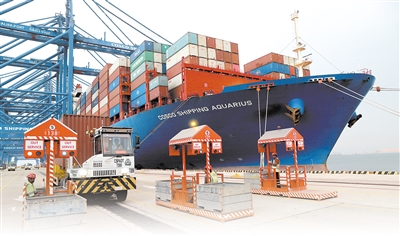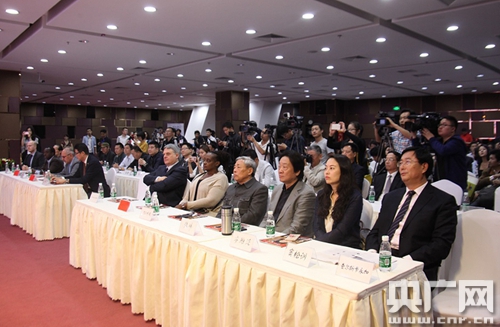Together, The "Belt And Road" Provides New Solutions For Global Governance
Together, The "Belt And Road" Provides New Solutions For Global Governance
Wang Wen has been on the rise and fall of unilateralism, protectionism and isolationism, and various conflicts and turmoil have emerged one after another. Global economic growth has been weak, and some countries have frequently withdrawn from international cooperation mechanisms and platforms, and the global governance system has become disorderly and ineffective.
Wang Wen
In recent years, unilateralism, protectionism, and isolationism have spread, various conflicts and turmoil have emerged one after another, global economic growth has been weak, some countries have frequently withdrawn from international cooperation mechanisms and platforms, and the global governance system has become disorderly and ineffective. As an inclusive global public products and international cooperation platform, the initiative has not only made significant progress in policy communication, facility connectivity, smooth trade, financial communication, people-to-people communication and cooperation in new fields, but also outlines new visions and opens up new spaces for global development with its unique practical logic and governance effectiveness.
From the perspective of "hard connectivity", the joint construction of the "Belt and Road" initiative has solved the global governance deficit and broken structural obstacles and key bottlenecks in global economic governance by improving the infrastructure development level of developing countries. The total number of China-Europe freight trains has exceeded 110,000, opening up the artery of the Eurasian continent and becoming a "life channel" to ensure the stability of the industrial chain and supply chain of Asian and European countries, effectively hedging the failure of global governance under trade barriers. The construction of important ports such as the Port of Piraeus in Greece, Gwadar in Pakistan, Hambantota in Sri Lanka, and Kyaukpyu in Myanmar is reshaping the world's maritime transportation pattern, significantly improving the regional logistics efficiency and the resilience of the global trade network. The construction of cross-regional backbone channels such as Jakarta-Bandung High-speed Railway, Mombasa-Nairobi Railway, Asia-Djiboutique Railway, Hungary-Serbia-Serbia-Laos Railway, and China-Laos Railway have become a key lever for activating regional economy and improving people's livelihood and welfare. The joint construction of the "Belt and Road" takes facility connectivity as the first breakthrough point, accurately focuses on the infrastructure construction gap in global governance, and with the Chinese wisdom of "get rich and build roads first", it effectively reduces the cost of commodity trading and circulation among regions, releases the development potential that is tethered by geographical isolation, and lays a solid physical foundation for bridging the global development gap and achieving more inclusive global economic governance.
From the perspective of "soft connectivity", the "Belt and Road" initiative, with the basic principle of consultation, joint construction and sharing, has innovated the supply of rules, optimized mechanisms, standards and concepts such as international trade and financial investment, and is committed to creating more fair, efficient and global governance rules that are adapted to diversified needs. Not only will it promote planning coordination, mutual recognition of standards and innovation in concepts between my country and other countries, but it will also enhance the adaptability and tolerance of co-construction countries in the complex challenges of global game, and the ability of various actors to shape global governance rules and interaction methods has also been greatly enhanced. The China-Europe Express has promoted the coordination and simplification of rules and procedures for jointly building countries in customs clearance, quarantine and other aspects. The completion of many major infrastructure projects has broken down obstacles such as bilateral and multilateral transportation agreements and gauge standards, providing useful reference for cross-border rules compatibility. Under the guidance of the green development concept of jointly building the "Belt and Road", international new energy standards such as hydropower, wind power, photovoltaics, etc. that my country leads or participates in formulating are widely used to help respond to climate change and promote green governance rules. More than 100 industrial parks built in my country emphasize the intersection of interests on the basis of equality and the sharing of interests in common participation, guiding enterprises to realize their own interests and promote their own development while taking into account the local interests of the host country and forming new cooperative advantages.
From the perspective of "heart-to-heart connectivity", the joint construction of the "Belt and Road" initiative reshapes the development paradigm, triggers the redefinition and exploration of the essence of development, empowers domestic governance in various countries, and provides new perspectives and new methods for resolving the deep-seated contradictions in global governance. More and more "small and beautiful" people's livelihood projects focus on meeting more down-to-earth universal needs for people's livelihood, enhancing the sense of gain and happiness of the people who build a country together. For example, the "Wancun Connect" project connects satellite TV to tens of thousands of remote villages in Africa, providing a platform for locals to better understand the world and broaden their horizons; my country's mushroom grass technology has been promoted to 107 countries, helping farmers quickly invest in industries with higher added value such as mushrooms and livestock; cooperating with 30 countries to build 34 overseas school brands such as Luban Workshops, and carrying out vocational skills training and scientific and technological cooperation in hundreds of countries, committed to cultivating local talents and improving their independent development capabilities. The Asian Infrastructure Investment Bank and the Silk Road Fund provide diversified financing options for hundreds of projects, complementing traditional international financial institutions, providing developing countries with financing options that are more in line with their development stages and needs, and enriching the governance toolbox for global development financing.
The contribution of jointly building the "Belt and Road" to improving and improving global governance is obvious to all. It not only significantly improves the level of infrastructure connectivity and activates the potential of regional economic cooperation, but also innovates the mechanism for coordination of rules and mutual recognition of standards to promote the innovation of development concepts. We must also see that in the complex and changing international environment, the joint construction of the "Belt and Road" still faces some difficulties and challenges. For example, some "hard China Unicom" projects need to conduct more refined control of geopolitical and debt risks, and the coordination of rules and mutual recognition of many "soft China Unicom" still needs to be further expanded. Despite this, in the face of the external environment where uncertainty is significantly enhanced, the certainty of the joint construction of the "Belt and Road" initiative is obvious. It is not only a railway crossing the mainland and a port that revitalizes, but also contains Eastern wisdom on how to achieve more effective, inclusive and sustainable global governance.
(The author is the dean of the Chongyang Institute of Finance of Renmin University of China and the dean of the School of Global Leadership)





